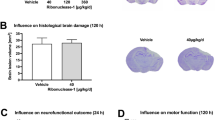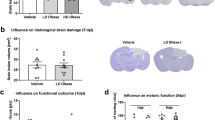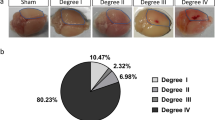Abstract
Traumatic brain injury (TBI) is recognized as a global health problem due to its increasing occurrence, challenging treatment, and persistent impacts on brain pathophysiology. Neural cell death in patients with TBI swiftly causes inflammation in the injured brain areas, which is recognized as focal brain inflammation. Focal brain inflammation causes secondary brain injury by exacerbating brain edema and neuronal death, while also exerting divergent beneficial effects, such as sealing the damaged limitans and removing cellular debris. Recent evidence from patients with TBI and studies on animal models suggest that brain inflammation after TBI is not only restricted to the focal lesion but also disseminates to remote areas of the brain. The dissemination of inflammation has been detected within days after the primary injury and persists chronically. This state of inflammation may be related to remote complications of TBI in patients, such as hyperthermia and hypopituitarism, and may lead to progressive neurodegeneration, such as chronic traumatic encephalopathy. Future studies should focus on understanding the mechanisms that govern the initiation and propagation of brain inflammation after TBI and its impacts on post-trauma brain pathology.
This is a preview of subscription content, access via your institution
Access options
Subscribe to this journal
Receive 12 digital issues and online access to articles
$119.00 per year
only $9.92 per issue
Buy this article
- Purchase on Springer Link
- Instant access to full article PDF
Prices may be subject to local taxes which are calculated during checkout


Similar content being viewed by others
References
Corps, K. N., Roth, T. L. & McGavern, D. B. Inflammation and neuroprotection in traumatic brain injury. JAMA Neurol. 72, 355–362 (2015).
Jassam, Y. N., Izzy, S., Whalen, M., McGavern, D. B. & El Khoury, J. Neuroimmunology of traumatic brain injury: time for a paradigm shift. Neuron 95, 1246–1265 (2017).
GBD 2016 Traumatic Brain Injury and Spinal Cord Injury Collaborators. Global, regional, and national burden of traumatic brain injury and spinal cord injury, 1990–2016: a systematic analysis for the Global Burden of Disease Study 2016. Lancet Neurol. 18, 56–87 (2019).
Stocchetti, N. et al. Severe traumatic brain injury: targeted management in the intensive care unit. Lancet Neurol. 16, 452–464 (2017).
Wilson, L. et al. The chronic and evolving neurological consequences of traumatic brain injury. Lancet Neurol. 16, 813–825 (2017).
Blennow, K. et al. Traumatic brain injuries. Nat. Rev. Dis. Prim. 2, 16084 (2016).
Maas, A. I., Stocchetti, N. & Bullock, R. Moderate and severe traumatic brain injury in adults. Lancet Neurol. 7, 728–741 (2008).
Lingsma, H. F., Roozenbeek, B., Steyerberg, E. W., Murray, G. D. & Maas, A. I. Early prognosis in traumatic brain injury: from prophecies to predictions. Lancet Neurol. 9, 543–554 (2010).
Chandran, R. et al. A combination antioxidant therapy to inhibit NOX2 and activate Nrf2 decreases secondary brain damage and improves functional recovery after traumatic brain injury. J. Cereb. Blood. Flow. Metab. 38, 1818–1827 (2018).
Hinzman, J. M., Wilson, J. A., Mazzeo, A. T., Bullock, M. R. & Hartings, J. A. Excitotoxicity and metabolic crisis are associated with spreading depolarizations in severe traumatic brain injury patients. J. Neurotrauma 33, 1775–1783 (2016).
Russo, M. V. & McGavern, D. B. Inflammatory neuroprotection following traumatic brain injury. Science 353, 783–785 (2016).
Roth, T. L. et al. Transcranial amelioration of inflammation and cell death after brain injury. Nature 505, 223–228 (2014).
Yang, Y. et al. ST2/IL-33-dependent microglial response limits acute ischemic brain injury. J. Neurosci. 37, 4692–4704 (2017).
Liesz, A. et al. DAMP signaling is a key pathway inducing immune modulation after brain injury. J. Neurosci. 35, 583–598 (2015).
Hsieh, C. L. et al. CCR2 deficiency impairs macrophage infiltration and improves cognitive function after traumatic brain injury. J. Neurotrauma 31, 1677–1688 (2014).
Clausen, F., Lorant, T., Lewen, A. & Hillered, L. T lymphocyte trafficking: a novel target for neuroprotection in traumatic brain injury. J. Neurotrauma 24, 1295–1307 (2007).
Morganti, J. M. et al. CCR2 antagonism alters brain macrophage polarization and ameliorates cognitive dysfunction induced by traumatic brain injury. J. Neurosci. 35, 748–760 (2015). (2015).
Chen, X. et al. Omega-3 polyunsaturated fatty acid supplementation attenuates microglial-induced inflammation by inhibiting the HMGB1/TLR4/NF-kappaB pathway following experimental traumatic brain injury. J. Neuroinflamm. 14, 143 (2017).
Chio, C. C. et al. Exercise attenuates neurological deficits by stimulating a critical HSP70/NF-κB/IL-6/synapsin I axis in traumatic brain injury rats. J. Neuroinflamm. 14, 90 (2017).
Niemela, J. et al. IFN-β regulates CD73 and adenosine expression at the blood-brain barrier. Eur. J. Immunol. 38, 2718–2726 (2008).
Cekic, C. & Linden, J. Purinergic regulation of the immune system. Nat. Rev. Immunol. 16, 177–192 (2016).
Szmydynger-Chodobska, J., Strazielle, N., Zink, B. J., Ghersi-Egea, J. F. & Chodobski, A. The role of the choroid plexus in neutrophil invasion after traumatic brain injury. J. Cereb. Blood. Flow. Metab. 29, 1503–1516 (2009).
Semple, B. D., Bye, N., Rancan, M., Ziebell, J. M. & Morganti-Kossmann, M. C. Role of CCL2 (MCP-1) in traumatic brain injury (TBI): evidence from severe TBI patients and CCL2-/- mice. J. Cereb. Blood. Flow. Metab. 30, 769–782 (2010).
Homsi, S. et al. Blockade of acute microglial activation by minocycline promotes neuroprotection and reduces locomotor hyperactivity after closed head injury in mice: a twelve-week follow-up study. J. Neurotrauma 27, 911–921 (2010).
Dohi, K. et al. Gp91phox (NOX2) in classically activated microglia exacerbates traumatic brain injury. J. Neuroinflamm. 7, 41 (2010).
Edwards, P. et al. Final results of MRC CRASH, a randomised placebo-controlled trial of intravenous corticosteroid in adults with head injury-outcomes at 6 months. Lancet 365, 1957–1959 (2005).
Erturk, A. et al. Interfering with the chronic immune response rescues chronic degeneration after traumatic brain injury. J. Neurosci. 36, 9962–9975 (2016).
Johnson, V. E. et al. Inflammation and white matter degeneration persist for years after a single traumatic brain injury. Brain 136, 28–42 (2013).
Ramlackhansingh, A. F. et al. Inflammation after trauma: microglial activation and traumatic brain injury. Ann. Neurol. 70, 374–383 (2011).
Folkersma, H. et al. Widespread and prolonged increase in (R)-(11)C-PK11195 binding after traumatic brain injury. J. Nucl. Med. 52, 1235–1239 (2011).
Coughlin, J. M. et al. Neuroinflammation and brain atrophy in former NFL players: An in vivo multimodal imaging pilot study. Neurobiol. Dis. 74, 58–65 (2015).
Coughlin, J. M. et al. Imaging of glial cell activation and white matter integrity in brains of active and recently retired national football league players. JAMA Neurol. 74, 67–74 (2017).
Liddelow, S. A. & Barres, B. A. Reactive astrocytes: production, function, and therapeutic potential. Immunity 46, 957–967 (2017).
Burda, J. E., Bernstein, A. M. & Sofroniew, M. V. Astrocyte roles in traumatic brain injury. Exp. Neurol. 275(Pt 3), 305–315 (2016).
Gao, T. L. et al. Expression of HMGB1 and RAGE in rat and human brains after traumatic brain injury. J. Trauma Acute Care Surg. 72, 643–649 (2012).
Pan, H., Wang, H., Wang, X., Zhu, L. & Mao, L. The absence of Nrf2 enhances NF-kappaB-dependent inflammation following scratch injury in mouse primary cultured astrocytes. Mediat. Inflamm. 2012, 217580 (2012).
Almeida-Suhett, C. P., Li, Z., Marini, A. M., Braga, M. F. & Eiden, L. E. Temporal course of changes in gene expression suggests a cytokine-related mechanism for long-term hippocampal alteration after controlled cortical impact. J. Neurotrauma 31, 683–690 (2014).
White, T. E. et al. Gene expression patterns following unilateral traumatic brain injury reveals a local pro-inflammatory and remote anti-inflammatory response. BMC Genom. 14, 282 (2013).
Frieler, R. A. et al. Depletion of macrophages in CD11b diphtheria toxin receptor mice induces brain inflammation and enhances inflammatory signaling during traumatic brain injury. Brain Res. 1624, 103–112 (2015).
Lagraoui, M. et al. Controlled cortical impact and craniotomy induce strikingly similar profiles of inflammatory gene expression, but with distinct kinetics. Front. Neurol. 3, 155 (2012).
Dalgard, C. L. et al. The cytokine temporal profile in rat cortex after controlled cortical impact. Front. Mol. Neurosci. 5, 6 (2012).
Niesman, I. R. et al. Traumatic brain injury enhances neuroinflammation and lesion volume in caveolin deficient mice. J. Neuroinflamm. 11, 39 (2014).
Dash, P. K., Mach, S. A. & Moore, A. N. Regional expression and role of cyclooxygenase-2 following experimental traumatic brain injury. J. Neurotrauma 17, 69–81 (2000).
Chen, X. H., Johnson, V. E., Uryu, K., Trojanowski, J. Q. & Smith, D. H. A lack of amyloid beta plaques despite persistent accumulation of amyloid beta in axons of long-term survivors of traumatic brain injury. Brain. Pathol. 19, 214–223 (2009).
Crane, P. K. et al. Association of traumatic brain injury with late-life neurodegenerative conditions and neuropathologic findings. JAMA Neurol. 73, 1062–1069 (2016).
Kumar, R. G. et al. Acute CSF interleukin-6 trajectories after TBI: associations with neuroinflammation, polytrauma, and outcome. Brain Behav. Immun. 45, 253–262 (2015).
Roberts, D. J. et al. Association between the cerebral inflammatory and matrix metalloproteinase responses after severe traumatic brain injury in humans. J. Neurotrauma 30, 1727–1736 (2013).
Adamczak, S. et al. Inflammasome proteins in cerebrospinal fluid of brain-injured patients as biomarkers of functional outcome: clinical article. J. Neurosurg. 117, 1119–1125 (2012).
Zhang, J. et al. Traumatic brain injury-associated coagulopathy. J. Neurotrauma 29, 2597–2605 (2012).
Tian, Y. et al. Brain-derived microparticles induce systemic coagulation in a murine model of traumatic brain injury. Blood 125, 2151–2159 (2015).
Shlosberg, D., Benifla, M., Kaufer, D. & Friedman, A. Blood-brain barrier breakdown as a therapeutic target in traumatic brain injury. Nat. Rev. Neurol. 6, 393–403 (2010).
Scheid, R., Preul, C., Gruber, O., Wiggins, C. & von Cramon, D. Y. Diffuse axonal injury associated with chronic traumatic brain injury: evidence from T2*-weighted gradient-echo imaging at 3 T. AJNR Am. J. Neuroradiol. 24, 1049–1056 (2003).
Iwamura, A. et al. Diffuse vascular injury: convergent-type hemorrhage in the supratentorial white matter on susceptibility-weighted image in cases of severe traumatic brain damage. Neuroradiology 54, 335–343 (2012).
Glushakova, O. Y., Johnson, D. & Hayes, R. L. Delayed increases in microvascular pathology after experimental traumatic brain injury are associated with prolonged inflammation, blood-brain barrier disruption, and progressive white matter damage. J. Neurotrauma 31, 1180–1193 (2014).
Massberg, S. et al. Reciprocal coupling of coagulation and innate immunity via neutrophil serine proteases. Nat. Med. 16, 887–896 (2010).
Swystun, L. L. & Liaw, P. C. The role of leukocytes in thrombosis. Blood 128, 753–762 (2016).
Thompson, H. J., Pinto-Martin, J. & Bullock, M. R. Neurogenic fever after traumatic brain injury: an epidemiological study. J. Neurol. Neurosurg. Psychiatry 74, 614–619 (2003).
Jiang, J. Y., Gao, G. Y., Li, W. P., Yu, M. K. & Zhu, C. Early indicators of prognosis in 846 cases of severe traumatic brain injury. J. Neurotrauma 19, 869–874 (2002).
Behr, R., Erlingspiel, D. & Becker, A. Early and longtime modifications of temperature regulation after severe head injury. Prognostic implications. Ann. N. Y. Acad. Sci. 813, 722–732 (1997).
Heindl, U. T. & Laub, M. C. Outcome of persistent vegetative state following hypoxic or traumatic brain injury in children and adolescents. Neuropediatrics 27, 94–100 (1996).
Sazbon, L. & Groswasser, Z. Outcome in 134 patients with prolonged posttraumatic unawareness. Part 1: Parameters determining late recovery of consciousness. J. Neurosurg. 72, 75–80 (1990).
Thompson, H. J., Hoover, R. C., Tkacs, N. C., Saatman, K. E. & McIntosh, T. K. Development of posttraumatic hyperthermia after traumatic brain injury in rats is associated with increased periventricular inflammation. J. Cereb. Blood. Flow. Metab. 25, 163–176 (2005).
Tanriverdi, F. et al. Pituitary dysfunction after traumatic brain injury: a clinical and pathophysiological approach. Endocr. Rev. 36, 305–342 (2015).
Zheng, P., He, B., Guo, Y., Zeng, J. & Tong, W. Decreased apparent diffusion coefficient in the pituitary and correlation with hypopituitarism in patients with traumatic brain injury. J. Neurosurg. 123, 75–80 (2015).
Kasturi, B. S. & Stein, D. G. Traumatic brain injury causes long-term reduction in serum growth hormone and persistent astrocytosis in the cortico-hypothalamo-pituitary axis of adult male rats. J. Neurotrauma 26, 1315–1324 (2009).
Tanriverdi, F. et al. Antipituitary antibodies after traumatic brain injury: is head trauma-induced pituitary dysfunction associated with autoimmunity? Eur. J. Endocrinol. 159, 7–13 (2008).
Stocchetti, N. & Zanier, E. R. Chronic impact of traumatic brain injury on outcome and quality of life: a narrative review. Crit. Care. 20, 148 (2016).
McKee, A. C., Daneshvar, D. H., Alvarez, V. E. & Stein, T. D. The neuropathology of sport. Acta Neuropathol. 127, 29–51 (2014).
Hayes, J. P. et al. Mild traumatic brain injury is associated with reduced cortical thickness in those at risk for Alzheimer’s disease. Brain 140, 813–825 (2017).
Cherry, J. D. et al. Microglial neuroinflammation contributes to tau accumulation in chronic traumatic encephalopathy. Acta Neuropathol. Commun. 4, 112 (2016).
Ghosh, S. et al. Sustained interleukin-1β overexpression exacerbates tau pathology despite reduced amyloid burden in an Alzheimer’s mouse model. J. Neurosci. 33, 5053–5064 (2013).
Maphis, N. et al. Reactive microglia drive tau pathology and contribute to the spreading of pathological tau in the brain. Brain 138, 1738–1755 (2015).
Immonen, R. J. et al. Distinct MRI pattern in lesional and perilesional area after traumatic brain injury in rat—11 months follow-up. Exp. Neurol. 215, 29–40 (2009).
Evans, T. M. et al. The effect of mild traumatic brain injury on peripheral nervous system pathology in wild-type mice and the G93A mutant mouse model of motor neuron disease. Neuroscience 298, 410–423 (2015).
Schmidt, S. et al. Genes and environmental exposures in veterans with amyotrophic lateral sclerosis: the GENEVA study. Rationale, study design and demographic characteristics. Neuroepidemiology 30, 191–204 (2008).
Schmidt, S., Kwee, L. C., Allen, K. D. & Oddone, E. Z. Association of ALS with head injury, cigarette smoking and APOE genotypes. J. Neurol. Sci. 291, 22–29 (2010).
Lehman, E. J., Hein, M. J., Baron, S. L. & Gersic, C. M. Neurodegenerative causes of death among retired National Football League players. Neurology 79, 1970–1974 (2012).
Wu, J. et al. Spinal cord injury causes brain inflammation associated with cognitive and affective changes: role of cell cycle pathways. J. Neurosci. 34, 10989–11006 (2014).
Gyoneva, S. & Ransohoff, R. M. Inflammatory reaction after traumatic brain injury: therapeutic potential of targeting cell-cell communication by chemokines. Trends Pharmacol. Sci. 36, 471–480 (2015).
Weckbach, S. et al. Challenging the role of adaptive im munity in neurotrauma: Rag1 -/- mice lacking mature B and T cells do not show neuroprotection after closed head injury. J. Neurotrauma 29, 1233–1242 (2012).
Mencl, S. et al. FTY720 does not protect from traumatic brain injury in mice despite reducing posttraumatic inflammation. J. Neuroimmunol. 274, 125–131 (2014).
Cuevas-Diaz Duran, R., Wei, H. & Wu, J. Q. Single-cell RNA-sequencing of the brain. Clin. Transl. Med. 6, 20 (2017).
Neumann, J. et al. Very-late-antigen-4 (VLA-4)-mediated brain invasion by neutrophils leads to interactions with microglia, increased ischemic injury and impaired behavior in experimental stroke. Acta Neuropathol. 129, 259–277 (2015).
Odoardi, F. et al. T cells become licensed in the lung to enter the central nervous system. Nature 488, 675–679 (2012).
Herz, J., Filiano, A. J., Smith, A., Yogev, N. & Kipnis, J. Myeloid cells in the central nervous system. Immunity 46, 943–956 (2017).
Prinz, M. & Priller, J. The role of peripheral immune cells in the CNS in steady state and disease. Nat. Neurosci. 20, 136–144 (2017).
Peter, I. et al. Anti-tumor necrosis factor therapy and incidence of Parkinson disease among patients with inflammatory bowel disease. JAMA Neurol. 75, 939–946 (2018).
Heneka, M. T., Golenbock, D. T. & Latz, E. Innate immunity in Alzheimer’s disease. Nat. Immunol. 16, 229–236 (2015).
Acknowledgements
Work in the authors’ laboratories was supported in part by grants from the National Science Foundation of China (Grant numbers 81720108015, 91642205, and 81830038), National Key Research and Development Program of China (2018YFC1312200), Tianjin Municipal Science and Technology Commission (15ZXLCSY00060), funds from the Advanced Innovation Center for Human Brain Protection, Capital Medical University, Beijing, China, and Barrow Neurological Foundation. We thank Elaine Shi for providing editorial assistance.
Author contributions
F.-D.S., J.Z. and J.F.D. formulated the concept, K.S. performed the literature search. All authors contributed to drafting the manuscript.
Author information
Authors and Affiliations
Corresponding author
Ethics declarations
Competing interest
The authors declare that there is no conflict of interest.
Rights and permissions
About this article
Cite this article
Shi, K., Zhang, J., Dong, Jf. et al. Dissemination of brain inflammation in traumatic brain injury. Cell Mol Immunol 16, 523–530 (2019). https://doi.org/10.1038/s41423-019-0213-5
Received:
Accepted:
Published:
Issue Date:
DOI: https://doi.org/10.1038/s41423-019-0213-5
Keywords
This article is cited by
-
Dose-Dependent Tranexamic Acid Blunting of Penumbral Leukocyte Mobilization and Blood–Brain Barrier Permeability Following Traumatic Brain Injury: An In Vivo Murine Study
Neurocritical Care (2024)
-
IL-1R1 signaling in TBI: assessing chronic impacts and neuroinflammatory dynamics in a mouse model of mild closed-head injury
Journal of Neuroinflammation (2023)
-
Cdk5 mediates rotational force-induced brain injury
Scientific Reports (2023)
-
Bidirectional Communication Between the Brain and Other Organs: The Role of Extracellular Vesicles
Cellular and Molecular Neurobiology (2023)
-
A Through-Intact-Skull (TIS) chronic window technique for cortical structure and function observation in mice
eLight (2022)



